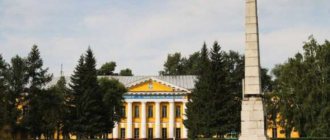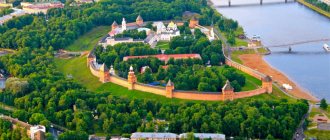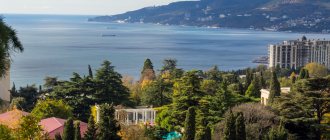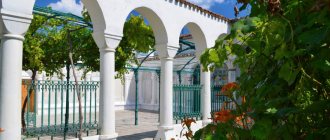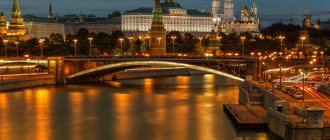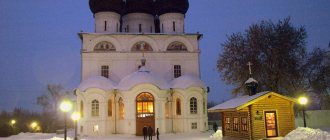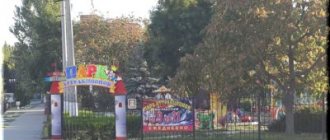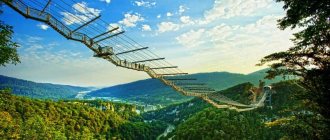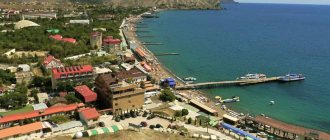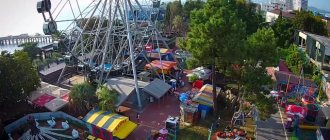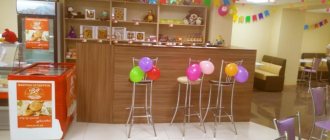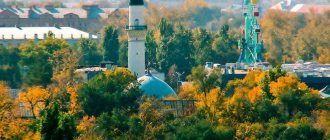- September 2, 2018
- Tips for tourists
- Lyudmila Sinitsyna
Pskov is a fairly popular and interesting city in Russia. Many people often have the question of where to go in Pskov with children, because the children’s program is completely different from the leisure activities for adults. They don’t like going to museums and listening to long and tedious lectures; they need vivid emotions and impressions. This article contains information about interesting places in Pskov that they will definitely like.
Aquapark
The Aquapolis water park in Pskov is the only water park not only in the city, but also in the region. But don’t worry that there won’t be enough space for someone. The Aquapolis water park in Pskov is ready to receive at least 800 people a day, so everyone will get tickets. Even on weekends, when the locker rooms are crowded, visitors have the opportunity to have a great rest without violating someone else's personal space.
The water park provides entertainment services of various types: you can ride on water slides of different shapes and heights, swim peacefully in the pool, bask in the jacuzzi, sit comfortably on a sun lounger in the recreation area, if you wish, take a steam bath in a Finnish or Russian bathhouse, or visit the spa complex.
The locker room has spacious drawers, storage rooms for personal belongings, toilets and rest rooms.
There is a wonderful bar and cafe where you can always refresh yourself if you are hungry after an active holiday.
Like Rome and Paris!
Pskov has a leopard on its coat of arms. Why is that? After all, there are no leopards in the Pskov forests. But the people of Pskov are just as brave as this beast. They killed many enemies. Who didn’t come with fire and sword to their lands! And no wonder: Pskov was one of the richest and largest cities in Europe. It amazed foreigners so much that it was compared to Paris and Rome. And one German chronicler wrote six hundred years ago: “There is no city in Germany equal to Pskov.” Pskov even minted its own coins: on the one hand, Prince Dovmont, the patron of the city, and on the other, the leopard. But at that time, only three Russian cities, besides Pskov, had their own coins - Novgorod, Tver and Moscow!
That is why so many people wanted to take possession of Pskov. The Pskovites had to defend themselves and drive away the invaders. And raids on their city happened so often that even a saying was born: “We fight for a year, we burn for a year, we trade for a year.” Along with men, women also defended their city. Therefore, Pskov was the only Russian city where in former times one could meet women dressed in men’s dress: it was more convenient to fight in men’s clothing.
Horse rides
The weekend has arrived and you need to plan a vacation? If you don’t know where to go in Pskov with children, we recommend trying horseback riding. In Pskov, a number of companies are engaged in keeping and training horses, so there is always a choice: the equestrian club “Vozrozhdenie”, “First Horse”, KSK “Rodina”, Pskov Hippodrome. Be careful: you must contact the owners of the equestrian club in advance and find out if there are free places for that day.
Usually horseback riding is accompanied by an instructor. Yes, you will not be able to take the reins and rush across the field in solitude. Most likely, the worker will walk next to the child and lead his horse by the bridle. If the children are already adults and independent, they know how to stay in the saddle and lead a horse, then the instructor will simply ride alongside to provide backup if necessary.
Three wonderful rays
Princess Olga once drove through the Izborsk lands. And she stopped to rest at the place where the Velikaya River merges with the Pskova River. And there is a high cape. On the cape there are untouched forests. The place is harsh, inaccessible, and the day was cloudy. But suddenly the gray clouds parted for a short while, as if a window had opened in the sky, and through it three bright rays of sunshine fell on the cape. It was an amazing sight, one might say - a sign from Heaven. “Three rays are like the three Persons of the Holy Trinity,” Princess Olga thought then. And she commanded: “There will be a great city and a temple in this place for the glory of the Trinity.” No sooner said than done. Builders arrived at the high cape, and soon a new city was born
Pskov is a heroic outpost of the Russian land. He grew by leaps and bounds. The city of Izborsk very quickly outgrew and became the main city in these areas. Princess Olga herself first installed a worship cross in it, and then ordered the construction of the first - still wooden - church in the name of the Holy Trinity in Pskov. This temple had a very unusual fate: until the 14th century in Rus' there would no longer be a single temple in honor of the Holy Trinity. No one! When all of Rus' was already baptized, temples were built on its land in the name of Nicholas the Wonderworker, Elijah the Prophet, Sophia the Wisdom of God, the Protection of the Most Holy Theotokos and many other temples. But in the name of the Father, Son and Holy Spirit - in the name of the Holy Trinity - not a single one. Why did this happen? Here historians have only assumptions. First: Princess Olga decided to build a temple in honor of the Holy Trinity after seeing three luminous rays. And since no one else had such visions, the architects simply did not dare to build a temple again in the name of the Triune God. And the second assumption: since God is One, that means there should be only one temple in His Name, and it already exists - in Pskov.
A thousand years ago, Grand Duchess Olga lived, but her memory is still preserved on Pskov land. There is an island on the Velikaya River. It divides the river in two. The left channel is called Olginy Sludy, and the right one is called Olginy Vorota. They are named after Mother Pskov. And there is also a spring - Olga's key. They say that the Grand Duchess once washed herself in it. In Pskov itself there is the Olginsky Bridge, the largest in the city. And Olginskaya embankment, where a chapel was recently built in honor of the founder of Pskov. And Pskov itself is often called Olga’s city!
All residents of Pskov - Pskovites - know: Princess Olga is their countrywoman, originally from the village of Vybuty. There is now a memorial stone here, and historical festivals are held near Vybuty “Helga” - that was Olga’s name in her native dialect. At festivals everything is arranged as it was in the time of the princess. Its participants dress up in ancient costumes, compete in archery and mock battles, prepare treats according to ancient recipes, and sing folk songs.
Planetarium
Many people wonder where to go in Pskov with children to gain new knowledge. Mix business with pleasure. If you want your child not only to have fun in his free time, but also to study, feel free to go to the Pskov Planetarium.
The program here is designed for children over five years old. Animators are often invited to events and can talk about constellations and space in a fun way in the form of a lesson-game. The planetarium in Pskov is the best place to gain new knowledge. Children also like other forms of learning: fairy tales, riddles, interesting stories, lectures.
Rope park
Is your child a fountain of endless energy? Always wants to move, run, jump? Then go with him to the Malskaya Dolina rope park. Let him try his hand at passing sites of different difficulty levels. Children will not be allowed into the most difficult of them; they are not suitable for this category in terms of height and weight. Don't be afraid that your child will fall and get injured. First, a protective helmet will be placed on his head. Secondly, they will provide protection for your back, elbows and knees. Thirdly, it will be attached to a special cable at the waist. If he falls from a height, he will simply hang in the air until workers help him down.
The new emotions are breathtaking. The passage can take from twenty minutes to an hour. There are not only rope ladders, but also a climbing wall and trolley descents. On the territory of the park there are cafes and recreation areas, there is even a mini-menagerie.
Dovmontov city
And so Dovmont-Timofey proposed to rebuild and expand the Pskov Kremlin, but not just like that, but based on a special plan and symbolism.
What was the Kremlin like at that time? There was a temple on a hill at the confluence of the Velikaya and Pskova rivers. It was protected from behind by the river, and in front it was surrounded by a semicircular wall in the shape of an arc, from one bank to the other. This wall was the entrance to the Kremlin. In front of the temple there was a square where the veche gathered. And on the other side of the wall, the city immediately began, people lived there, and the city market was also located there.
What did Dovmont-Timofey propose? He came up with the idea of moving urban settlements a little further from the Kremlin wall in order to build another outer wall, the so-called second ring. And if inside the first wall - on the veche square near the temple - the veche gathers as the legislative power, then between the first and second walls the executive power was supposed to sit. The space between the first and second walls began to be called Dovmont's city.
In those days, the city of Pskov was divided into six ends-districts, and the rest of the Pskov region - into another 12 ends-districts. Prince Dovmont-Timofey proposed that all these 18 Pskov ends be represented in the Kremlin, on the territory of Dovmont’s city, and that the representation of each end would be... a temple. So six cathedrals appeared in the Kremlin - one from each end of the city. But the regional districts did not have enough money to build an entire temple-representation in the Kremlin. And then they were allowed to add their own chapel to the existing temple. Thus, 18 thrones appeared in the Kremlin cathedrals, representing 18 districts of the city and region. In each of them, a chronicle was kept and the seal of its region was kept, trade agreements were concluded and other important state affairs were carried out.
Skating rink "Tabletka"
In hot summer weather, there is nothing better than visiting the Tabletka indoor skating rink. There are arenas for professional skaters and amateurs. Recently, a separate room was allocated for the youngest visitors.
You can sharpen your skates at the entrance and rent them, but you can also bring your own. There is a cafe on site serving warm drinks. Discounts are available for children under seven years of age and large families.
Karaoke club
Many children love to sing songs, but this is not always possible to do at home. Thin walls and neighbors who love silence can become an obstacle. And at home you don’t always have the necessary equipment and a special atmosphere to feel like a popular singer. In Pskov, karaoke clubs “Mirozhka”, “Compliment”, “Podosye” and “Sokolikha” are in great demand.
These establishments have rooms for children and adults. The song selection is also divided by age. Children are provided with a so-called children's menu, a children's catalog in which they will find songs from cartoons and fairy tales. There is a large plasma hanging on the wall; not only text is visible on the screen, but also episodes from cartoons are reproduced. There is a karaoke cafe where you can quench your thirst and refresh yourself.
Where to stay in Pskov
For a city of 200 thousand inhabitants, Pskov offers a good selection of housing, since it is in demand as a tourist destination and not only. In winter, the tourist flow is less than in summer, so there should not be any difficulties with choice and accommodation. The most convenient hotels and apartments will be in the Center area, where most of the attractions are located.
- Pskov Hotels
- Hostels for Budget Travelers
- Flats and apartments
Book accommodation only on trusted portals. Cashback will be a bonus on Booking: Cashback promotion for Tourist. RU
Hotels with views of the Pskov Kremlin Photo: © DK1974
Entertainment Center
The weather outside is not always good. Sometimes it rains, snows, is cold or unbearably hot. But don’t leave your child without fun and relaxation. Entertainment centers come to the rescue. There are several places in Pskov that are worth paying attention to.
The first is children's entertainment. Pskov is a city with great opportunities. There is so much to this center! Swimming pool, spa, fitness club (only from 12 years old), martial arts room, tennis club. All this is located in one building. If your child likes to be active, then this place is just perfect. Not only will he have a good time and have fun, but he will also improve his health with regular exercise.
The second option is to go to a children's entertainment center in Pskov. Here you can have fun celebrating a birthday or other holiday. There are many slot machines and children's attractions. There is a labyrinth, trampolines, and a cinema. The center employs animators who are ready to turn into the hero of their favorite cartoon or fairy tale, play and sing a song.
And there is a holiday on our street!
Due to frequent attacks on the city, the Pskov residents were very careful and did not let just anyone in. First, they thoroughly figured out who he was, where he was coming from, and why he had come to Pskov. But the invited guests were greeted with joy, the gates were opened wide, and the guests of honor entered Pskov along the street, which was called Zvanitsa.
In general, the streets in Pskov were named after the saint, in whose honor a temple was built on this street. And the feast of this saint was celebrated together. And when these name days arrived, after the church service, tables were placed right on the street, and the holiday began. And they made sure to call residents from neighboring streets to this holiday.
For example, on Ilyin’s Day, returning from church, residents of Ilyinskaya Street gathered at a common table. Each carried what he could: one - pies, another - kvass, the third - honey, the fourth - porridge or turnips. And the feast began! And when the neighbors liked the treat especially strongly, when they looked with white envy at how their neighbors treated them and how everything worked out for them, then they told the owners: wait, there will be a holiday on our street, then come to us. And each tried to become famous in front of the other for its hospitality and ability to celebrate. “There will be a holiday on our street” - this is what many people say even today, this saying is known to everyone. But it was invented in Pskov.
Paintball club "Jaga-Jaga"
Looking for something different and energetic? The whole family can participate in this entertainment. The main rule is to agree on booking the site in advance, because there are many people interested, the rental is scheduled for several weeks in advance.
What is entertainment? You are put on special protective suits, a helmet and goggles. Then they give out weapons loaded with paint balls. Players are divided into two teams and come up with their own strategy to attack their opponents. The essence of the game can be different, you agree on this among yourself: victory is achieved either when all the enemy enemies are “shoot down”, or if a secret base is found.
The Jaga-Jaga paintball club is good because it has a huge area with various obstacles and places where you can hide from the enemy team. Playing paintball is a good way not only to have a wonderful weekend, but also to celebrate a birthday. This game develops strategic thinking, quick reaction, speed, accuracy, and the ability to work in a team.
Playgrounds
Where to go in Pskov with children without spending money? We suggest going to the playgrounds. Pskov can boast of their diversity. Almost every yard has a children's playground; we will list only the most popular ones.
The Finnish Park has the largest number of visits per day. Why is this playground in such high demand among visitors? Everything is quite simple: it has free children's attractions. Children's favorite thing is the giant ship. It has real sails and holds, as well as an anchor and rope ladders that can be lowered and hauled back up. Moreover, it is located in the city center, making it easy to reach.
Another site is called “Children’s Park of Pskov”. It is equipped with paid attractions and slides. Parents can pay their child for a ten-minute ride in a small electric car.
The park has a stage where interesting events and concerts are constantly held. In winter, children love to go down the ice slide. At this time it is noisy and fun here, as always.
Also in Pskov, twelve luxurious playgrounds with large slides, bars and crossbars, rubber rings, carousels and ladders were recently installed.
Museums
Winter is the best time to explore museums, because the weather is usually not very comfortable at this time. The warmth and comfort of city exhibitions will allow you to plunge deeper into the multi-layered history of Pskov and learn many amazing facts.
On the territory of the Kremlin, you should definitely look into the Prikaznye Chambers - an administrative building of the late 17th century, with white limestone, the type of porch and general solidity similar to the architecture of Pskov churches. One of the expositions of the Pskov Museum-Reserve, which is located inside, will tell about its history. In addition, there is also an exhibition “Mr. Pskov”, which will tell about how the medieval city lived and show unique archaeological finds made on its territory. The third exhibition opens the story in the person of A. L. Ordin-Nashchekin, the Pskov governor.
Expositions of the Executive Chambers Photo: © Andrey Panin
From the same time, the Pogankin Chambers , named after the merchant and built according to local architectural principles, have been preserved. They are also part of the museum-reserve; they should soon open after reconstruction as an exhibition site (according to the plan - in 2022).
What to see in Pskov in 1 day, 2 or 3 days
Pogankin chambers Photo: © vladkonst
The neighboring building nearby is the main one in the Pskov Museum-Reserve . Here you can get acquainted with several eras in the history and culture of the city. The exhibition “Culture and Art of Ancient Pskov” is intended to explain the versatility of creativity in different aspects of life. It presents jewelry, dishes, icons and other archaeological finds from the times of paganism and Christianity.
The exhibition “Pskov Region during the Second World War” is dedicated to famous military events of 1941-1945. Located in the very west of the country, Pskov was attacked by the fascist army in early July, and it was occupied for three long years. Exhibits with authentic artifacts tell about military operations in the city and its surroundings, about the life of the population under occupation, about the concentration camp operating nearby, about partisan and underground struggle.
Model of the Pskov Fortress in one of the museums Photo: © Andrey Panin
Postnikov's courtyard - chambers of the 17th century. in Zapskovye, built by the merchant Postnikov. Most of the time they were used for administrative needs; they housed a military unit, a prison, and workshops. Today the walls of the Court have become a museum.
Restoration work took place quite recently, and the exhibitions located there have already pleased the first visitors. Here you can learn more about life in the merchants' chambers, marvel at the variety of ancient crosses, skillful and symbolic, and also see ancient icons, for example, “The Holy Trinity with Selected Saints” from the mid-17th century.
More about what’s interesting on the windows of the city’s museums:
Museums of Pskov
Frescoes in the Transfiguration Cathedral of the Mirozh Monastery Photo: © Andrey Panin
petting zoo
It happens that children are afraid of big animals in real zoos, or maybe they just don’t like these places, because all the animals sit in cramped cages. If you want to introduce your child to the world of fauna, a petting zoo will come to the rescue. In Pskov there is a mini-zoo called “Bird Yard”.
The child will be able not only to see a variety of animals, but also to touch them. At the entrance you can buy food to feed the animals by hand. Despite the name, in the zoo you will find not only birds, but also camels, cows, fallow deer and even wild boars. Everyone can take free photographs as a souvenir and pet the animals.
Got into zahab
The white walls of Crom are very thick. Such that cars could easily drive on them as if they were on a road. And also - the towers are powerful, with narrow loophole windows through which you can shoot in all directions.
No one has ever lived inside Crom. There weren’t even princely chambers here. It was built only for defense against enemies. In special bins - cages - a large supply of food and weapons was stored here so that the defenders of the city could withstand a long siege. In peacetime, this reserve was inviolable and was guarded by special dogs - “Kromsky dogs”. Stealing from cages was considered a terrible crime. A little later, when guns began to be used instead of bows and arrows, a gunpowder warehouse was built on Krom.
But that's not all! In case the enemies defeat the gate, a trap has been set up in the Pskov fortress - a zahab. The word “zahab” comes from the Old Russian “okhaben”, which means “sleeve”. Indeed, this long narrow corridor resembles a sleeve. At the entrance to it there is a drawbridge, and at the exit there is another gate, strong and reliable. But few of the enemies managed to reach them. Having launched the enemy into a trap, the Pskovites raised the bridge on metal chains, and threw logs and stones on the enemy’s heads, poured boiling water and boiling resin. There was no way for them to go back, and there was nowhere to dodge in the narrow corridor. Don't go to Rus' with a sword!
Zoograd "Argus"
If your child has no preconceptions about places where animals are kept in captivity, then we recommend that you go to the Argus Zoo. This is an ecological zoo, more like a nature reserve. The enclosures here are spacious enough for the animals to move freely in the cage. They try to recreate conditions similar to their natural habitat for each species.
Here you will see a roe deer, an owl, a wolf and a fox, a swan, a raccoon, and a horse. Of course, it will be interesting to see the bear. However, he is too menacing and uncontrollable for a petting zoo, so he is kept in an enclosure. By the way, you can buy food for animals, but not all of them can be fed. You will understand this by the warning signs that hang on the cages. If there are special fences next to the animal, then children should not climb over them or reach out to the cage. These zoo residents will be fed by workers, you just have to watch the process.
Kaverin Museum “Two Captains”
We think that after reading this cult book, many children were inspired to travel and wanted to become pilots. If your child is inquisitive and dreams of visiting many countries in the future, take him to this museum. At the entrance you are greeted by a monument to Sanya Grigoriev and Ivan Tatarinov. The museum is divided into two parts.
In the first half, visitors will be told about the life and work of the great writer. They will introduce him to his family, children and friends. They will tell you how Kaverin came up with the idea to write this novel, which formed the basis of the work. In the second part, you will be able to find out all the details about the creation of the work: how the information was selected, who became the prototype for the main and secondary characters, what made the author change the ending, what ending was originally intended.
The museum has a shelf with various editions of the novel. It contains not only Russian versions, but also books from other countries.
Attractions
Most of Pskov's attractions can be found in the Center district, located on the site of the historical city, within the boundaries of the immense Pskov Fortress. The walk will be fascinating and will open more than one page of history: here are ancient Russian monuments and houses - witnesses of pre-revolutionary times, standards of the Soviet era and, of course, the present reality that cleverly unites them. Many are included in the Pskov Historical, Architectural and Art Museum-Reserve , which includes two dozen of the most valuable objects in the history of the city and its environs.
On Lenin Square Photo: © Sergey Vasilets
Pskovsky Krom
The Pskov Kremlin is undoubtedly the most attractive place for tourists. The silhouettes of ancient walls and towers attract guests, offering to learn about the distant and rich history of the city. They amaze with their power and surprise with the probability of their existence. The monochrome winter weather further emphasizes the impressiveness of the structure. Bright winter sunsets and sunrises add special charm to the landscape.
The Kremlin (Krom) is the heart of the Pskov fortress, the center of its control. It was protected by five fortress walls, the last of which now coincides with Zastennaya and Sverdlova streets. Krom occupies a narrow mountainous cape at the confluence of the Velikaya and Pskov rivers. Historians suggest that the settlement existed here back in the 8th century, and chronicle events mark it from the 10th century. The walls and towers of the fortress were strengthened and rebuilt many times. They saved Pskov and the borders of the state from invasion more than once. The need for them disappeared during the time of Peter I, when the borders of Russia moved closer to Europe. Work to restore the monument has been ongoing since the 1950s. Until now.
Read more: Pskov Kremlin
Pskovsky Krom Photo: © Andrey Panin
Trinity Cathedral
In the center of Krom rises the Trinity Cathedral - one of the tallest in Russia. The time of its initial appearance is unknown for certain, and the one that exists today is its fourth incarnation in 1699. Inside the cathedral is decorated with a seven-tiered iconostasis and shrines with the relics of princes Vsevolod-Gabriel and Dovmont-Timofey are stored.
Read more: Trinity Cathedral
Trinity Cathedral against the backdrop of the zahab - the narrow entrance to the Kremlin Photo: © Andrey Panin
Dovmontov city
Dovmontov city is the second tier of the Pskov fortress, lying at the foot of the Kremlin. It is not possible to pass by it in Krom. It appeared and became an administrative center in the 13th century. under Prince Dovmont-Timofey, from which its name came. In winter, not all the remains of its buildings are clearly visible, however, even covered with caps of snow, they clearly allow you to imagine how 17 churches fit into a small area.
Read more: Dovmontov city
Dovmontov city under the walls of Krom Photo: © vladkonst
Vlasyevskaya Tower
The Vlasyevskaya Tower forms part of the wall on the side of the river south of the Dovmontov city. This is a completely reconstructed part of the Pskov fortress, recreated back in the Soviet years on the basis of the first one. The original one was dismantled in the 1780s as it lost its significance and became dilapidated. Before that, it was one of the most important in the defense of the Kremlin, and also welcomed guests from the west.
The tower tent is two-tiered. There is an observation deck at the top, which offers views of the fortress walls, the Trinity Cathedral, the river and the Holguin Bridge. Inside it there is a small photo exhibition with views of Pskov Krom in past decades.
Read more: Vlasyevskaya Tower
In addition to this tower, the Ploskaya , Vysokaya and Varlaamovskaya towers , including with a guided tour.
Vlasyevskaya Tower Photo: © vladkonst
Ancient temples
A significant contribution to the appearance of Pskov is made by its temples of the 13th–16th centuries, which were not affected by the Mongol invasion. At any time of the year they refer to its originality. Their appearance is distinguished by clear features: a solid whitewashed main part, a wide onion dome holding a drum with traditional ornaments, as well as an unusual belfry - a wall with arches on one of the facades or standing separately next to it.
Due to their uniqueness and preservation, 10 Pskov churches are included in the UNESCO World Heritage List, but they are not the only ones that are impressive. Let’s note those that you will probably come across during your walk, even if you don’t look for them.
Church of St. Basil the Great on Gorka Photo: © DK1974
In the very center of Pskov, and once in the middle and peripheral part of the fortress, there are:
- the Church of St. Basil the Great on Gorka - it is distinguished by the semicircular ends of the quadrangle and numerous chapels, it harmoniously fits into the hill in the park, today called Children's, is included in the UNESCO List, services are held;
- very close to the Church of St. Nicholas the Wonderworker from Usokha - an active temple, a monument of the 16th century;
- The Church of the Intercession and Nativity of the Blessed Virgin Mary from Prolom next to the Intercession Tower is a functioning temple of an unusual appearance: a bell tower unites two symmetrical single-domed churches, one of which was mentioned already at the end of the 14th century.
Church of the Intercession and Nativity of the Blessed Virgin Mary from Prolom Photo: © DK1974
In Zapskovye, not far from Sovetskaya embankment, it is worth finding:
- the Church of Cosmas and Damian from Primostie - a temple of the 15th - 16th centuries, currently in operation, the ensemble includes a fence with a gate, although it is not completely preserved;
- Church of the Resurrection from the Stadishche - located further, dates back to a later time, a striking example of Pskov temple architecture with all the characteristic elements, a four-pillar belfry is installed on the porch;
- next door is the Church of Varlaam Khutynsky ;
- The Church of the Epiphany from Zapskovye is a temple that at one time introduced innovations into the traditions of religious buildings in Pskov: raised arches were covered with an eight-slope roof, and the belfry was located on a separate high wall.
Church of Varlaam Khutynsky Photo: © Andrey Panin
On the left bank of the Velikaya River, in Zavelichye, you should definitely see:
- the Cathedral of the Transfiguration of the Lord in the Spaso-Mirozhsky Monastery - a temple whose appearance is considered to be the 12th century, the main value is the oldest frescoes, similar in type to Byzantine ones and having no analogues in Russia;
- Cathedral of John the Baptist - the church of the former Ivanovo Monastery, today the courtyard of the Krypetsky Monastery, has three helmet-shaped domes, simple in external design, but dates back to the 12th century;
- Church of the Assumption of the Blessed Virgin Mary from Paromenia near the Olginsky Bridge - a temple of the 16th - 19th centuries built and altered, a small detail is crowned with a cross above the dome - a dove.
Church of the Assumption of the Blessed Virgin Mary from Paromegna Photo: © DK1974
In addition, it is worth noting the Cathedral of the Nativity of the Virgin Mary in the Snetogorsky Monastery on Snyatnaya Gora, which is on the northwestern outskirts of the city, on the banks of the Velikaya. In a 14th century temple. original paintings have been preserved - the Dormition of the Mother of God, the Nativity of the Mother of God, the Crucifixion and Resurrection of Christ and other subjects made in Pskov’s own technique.
All churches in Pskov
Monuments
Monuments are an indispensable feature of city streets. While walking around Pskov you will come across monuments dedicated to famous heroes of the past.
An important figure in the history of Pskov was Princess Olga, the first female ruler of Rus' in the mid-10th century. and the first to accept Christianity. It is with her that the founding of Pskov is associated. It began with the Trinity Cathedral on the spot where three rays of the sun fell. Many places in the city are dedicated to her, including two monuments erected for the 1100th anniversary of Pskov in 2003.
The monument to Princess Olga by Zurab Tsereteli depicts her as a warrior with a shield and sword. It is located on the left bank of the city in Riga Park.
Monument to Princess Olga (works by V. Klykov) Photo: © DK1974
The monument to Princess Olga by sculptor Vyacheslav Klykov is more popular since it is located in the city center. The four-meter-tall monument depicts the Holy Equal-to-the-Apostles Princess: her head is crowned with a halo, and she holds a cross in her hands. Nearby is a boy, son Vladimir, holding an icon with the face of Christ and later going down in history as the baptist of Rus'. The pedestal is decorated with bas-reliefs of twelve Christian saints. On Oktyabrskaya Square, where the figure of Olga is facing, the main festive fir tree of Pskov is erected for the New Year.
Behind the monument begins the Children's Park. In it you will find a monument dedicated to the heroes of the Pskov writer V.A. Kaverin, the heroes of the book “Two Captains” - Sanya Grigoriev and Ivan Tatarinov, cult heroes of the Soviet years. The park also has a sculpture “Pskov Skobar” . It stands in honor of all Pskov blacksmiths: according to legend, Peter the Great, who possessed remarkable strength, could not bend the Pskov staple.
Monument to A. S. Pushkin and the peasant woman Photo: © DK1974
Another significant person of the region is A.S. Pushkin. The poet’s family’s native place is located near the regional center in a place called the Pushkin Mountains. In Pskov, on the territory of the Summer Garden, a monument was erected to Pushkin and the peasant woman , in whom his nanny, Arina Rodionovna, is most often seen. In the form of sculpture, it personifies the people, and in general the closeness and unity of the great Russian poet with them.
One of the symbols of Pskov also became the “Battle on the Ice” monument on Mount Sokolikha, which is at the exit from the city towards Gdov. The monument depicts Alexander Nevsky and his squad, who distinguished themselves in April 1242 on Lake Peipus in the fight against the Livonian Order. It stands, of course, not at the site of the battle, but expresses the unity and courage that allowed the Russian people to win.
Monument “Battle on the Ice” Photo: © Sergey Vasilets
About these and other places also in the material:
Sights of Pskov
Drama Theater named after Alexander Sergeevich Pushkin
Many parents believe that children should be taught art from an early age. This does not mean that the child should be taken with him to adult plays that he will not be able to understand. The Drama Theater named after Alexander Sergeevich Pushkin regularly updates its repertoire. Here you will find a poster for children. Pskov is rich in interesting theaters; you will always find productions for every taste and age. Your child will be greatly impressed by the performance of professional actors, even if the action from an ordinary fairy tale takes place on stage.
Thanks to this theater, your children will love art and get acquainted with the plots of many works of art, as they are often taken as a basis. Excellent acting, well-chosen music and detailed scenery - that's what awaits you here.
Pskov Kremlin and its description
In an essay on the topic “My City of Pskov” one cannot fail to mention the Pskov Krom (Kremlin), which as of the 16th century included :
- Nine kilometers of fortress walls.
- 40 towers.
- 5 belts of stone fortifications.
- 14 gates.
At that time, this structure on three hectares was one of the most fortified and impregnable. Initially, all fortifications were built of wood on an earthen rampart. Stone walls appeared only in the middle of the 13th century, and towers began to be erected at the beginning of the 15th century.
In addition to powerful defensive structures, the Kremlin includes the Trinity Cathedral, Dovmontov Town and other buildings.
Most of the towers have been rebuilt and reconstructed several times over the past centuries. Of the entire length of the fortress walls, no more than one kilometer has survived.
Children's Library "Rainbow"
Do you think that in the library you are only allowed to sit quietly and read books? No matter how it is. The Rainbow Library does not fit this description at all. Firstly, it is an environmental library that fights for the rights of nature. Secondly, children's activities are held here every two days. Children make posters and crafts on various topics. For example, on the topic of the dangers of smoking and alcohol, the benefits of reading, etc.
Interactive sessions are held where participants talk about their pets, favorite book characters, and friends. Competitions are often held for the best drawing with colored chalk on asphalt.
All events are completely free.
